ACUFO-1932-00-00-GREENLANDEASTCOAST-1
Sometime before 1999, the Historical ufology website Project 1947 lead by U.S. ufologist Jan Aldrich listed an aircraft - UFO encounter report, written by Rufus Drake, titled “UFO Crisis over Greenland” and published in the US magazine SAGA UFO Report of October 1977.
Jan Aldrich cited the article:
The earliest UFO sighting by Danish fliers occurred in 1932 when three H. E. 8 seaplanes were dispatched to the east coast of Greenland to conduct a photogrammetric survey.
“In those days, manned aircraft had no heaters, insulation or pressure suits. Only the daring and hardy ventured into the glacier zone in wood and canvas planes, and many failed to return. The pilot during this particular UFO incident was Lt. Col. Peter Grunnet, a supremely rugged figure who lives quietly in retirement today. His copilot was Lt. Tage Anderson, who in later years became Commander-in-Chief of R. D. A. F., and died in 1961.”
“We had many adventures flying under primitive conditions in the frozen north,” says Grunnet. “But none compared with this.”
Huddled under body-length parkas and numbed by the cold, their breath forming clouds of condensation in front of them, Grunnet and Anderson coaxed the trouble-prone H. E. 8 over a mirror like section of sprawling glacier. Suddenly, the copilot spotted a second shadow pursuing the shadow of their seaplane across the ice.
“I looked back and saw something that didn't make sense,” Anderson was quoted.
About a mile behind their plane partly obscured by the glare of sun against snow, a flying object was following their flight course. Grunnet eased his throttle forward. The engines of his H. E. 8 gnashed and vibrated noisily as he forced the plane into a shallow turn, to get a better view of the alien object.
“It was nothing like flying machines of that period,” Grunnet, recalling the UFO sighting recently during a visit to the U. S. “It was hexagonal, flat, and seemingly made of aluminum or some other metal, with no breaks in the surface and no rivets.”
“At the time, I had a spooky feeling. I can't explain it. It was as if I 'felt' the presence of whoever was inside that craft--and the feeling was hostile. In the years since, I've realized that the craft was 'saucer' shaped, and I believe it really was a flying saucer.”
Jan Aldrich noted that the credibility of the case is questionable; he wondered whether it had been made up by the SAGA UFO Report writer. Jan Aldrich noted that U.S. ufologist Barry Greenwood tried to check the report by writing to the magazine; he learned that many of the published stories originated from letters the magazine received. But he had no luck in getting the magazine to show him their material.
So far as the plane and the circumstances of its use are concerned, the only credibility issue I found with this report is that the planes were Danish Navy planes, not Danish Air Force planes.
I found no information about “Lt. Col. Peter Grunnet”; of course that are many people named “Peter Grunnet” in Denmark, and the name might have been misspelled too.
I was able to partly confirm the identity of Tage Andersen - of course, not “Anderson”: he had been Chief in the Army Aviation Troops (not the Air Forces, not the Navy Air Service) with the rank of Colonel for about two years, 1945 - 1947. He was born in 1899 and died in 1965.
| Date: | 1932 |
|---|---|
| Time: | ? |
| Duration: | ? |
| First known report date: | October 1977. |
| Reporting delay: | 4 decades. |
| Country: | Denmark (Greenland) |
|---|---|
| State/Department: | East coast of Greenland |
| City or place: |
| Number of alleged witnesses: | 2 |
|---|---|
| Number of known witnesses: | ? |
| Number of named witnesses: | 2 |
| Reporting channel: | Rufus Drake in SAGA UFO Report magazine. |
|---|---|
| Visibility conditions: | Day, sunny. |
| UFO observed: | Yes. |
| UFO arrival observed: | No. |
| UFO departure observed: | ? |
| UFO action: | ? |
| Witnesses action: | Approach. |
| Photographs: | No. |
| Sketch(s) by witness(es): | No. |
| Sketch(es) approved by witness(es): | No. |
| Witness(es) feelings: | Puzzled. |
| Witnesses interpretation: | Flying saucer. |
| Sensors: |
[X] Visual: 2.
[ ] Airborne radar: N/A. [ ] Directional ground radar: N/A. [ ] Height finder ground radar: N/A. [ ] Photo: [ ] Film/video: [ ] EM Effects: [ ] Failures: [ ] Damages: |
|---|---|
| Hynek: | DD |
| Armed / unarmed: | 1 machine gun. |
| Reliability 1-3: | 1 |
| Strangeness 1-3: | 2 |
| ACUFO: | Possible extraterrestrial craft. |
[Ref. jah1:] JAN ALDRICH:
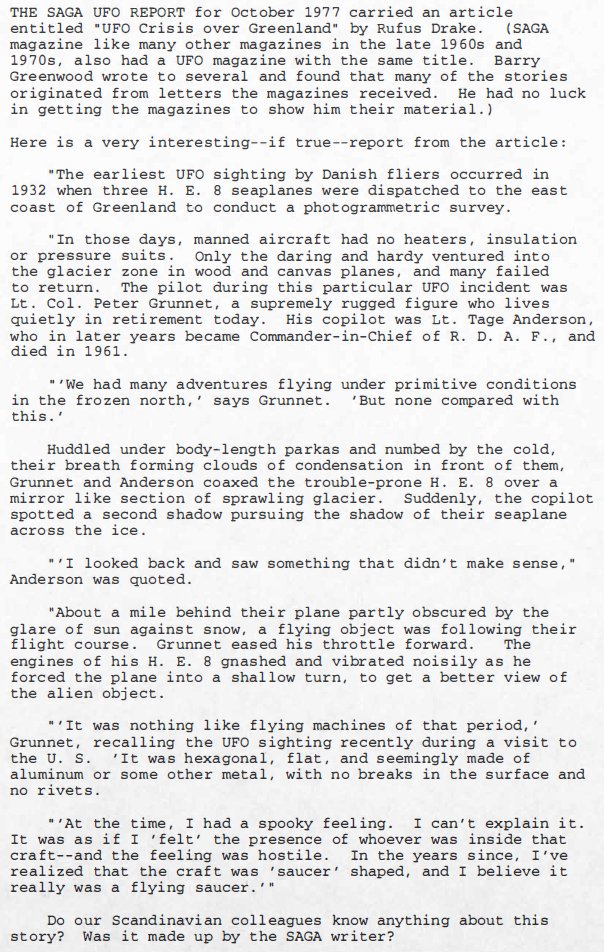
|
1932, Daytime, East Coast of Greenland, LTC Peter Grunnet and LT Tage Anderson, Royal Danish Air Force. (See account below.)
THE SAGA UFO REPORT for October 1977 carried an article entitled “UFO Crisis over Greenland” by Rufus Drake. (SAGA magazine like many other magazines in the late 1960s and 1970s, also had a UFO magazine with the same title. Barry Greenwood wrote to several and found that many of the stories originated from letters the magazines received. He had no luck in getting the magazines to show him their material.)
Here is a very interesting--if true--report from the article:
“The earliest UFO sighting by Danish fliers occurred in 1932 when three H. E. 8 seaplanes were dispatched to the east coast of Greenland to conduct a photogrammetric survey. ”In those days, manned aircraft had no heaters, insulation or pressure suits. Only the daring and hardy ventured into the glacier zone in wood and canvas planes, and many failed to return. The pilot during this particular UFO incident was Lt. Col. Peter Grunnet, a supremely rugged figure who lives quietly in retirement today. His copilot was Lt. Tage Anderson, who in later years became Commander-in-Chief of R. D. A. F., and died in 1961.
“'We had many adventures flying under primitive conditions in the frozen north,' says Grunnet. 'But none compared with this.'
Huddled under body-length parkas and numbed by the cold, their breath forming clouds of condensation in front of them, Grunnet and Anderson coaxed the trouble-prone H. E. 8 over a mirror like section of sprawling glacier. Suddenly, the copilot spotted a second shadow pursuing the shadow of their seaplane across the ice.
“'I looked back and saw something that didn't make sense,' Anderson was quoted.
“About a mile behind their plane partly obscured by the glare of sun against snow, a flying object was following their flight course. Grunnet eased his throttle forward. The engines of his H. E. 8 gnashed and vibrated noisily as he forced the plane into a shallow turn, to get a better view of the alien object.
“'It was nothing like flying machines of that period,' said Grunnet, recalling the UFO sighting recently during a visit to the U. S. 'It was hexagonal, flat, and seemingly made of aluminum or some other metal, with no breaks in the surface and no rivets.
“'At the time, I had a spooky feeling. I can't explain it. It was as if I 'felt' the presence of whoever was inside that craft--and the feeling was hostile. In the years since, I've realized that the craft was 'saucer' shaped, and I believe it really was a flying saucer.'”
Do our Scandinavian colleagues know anything about this story? Was it made up by the SAGA writer?
[Ref. prt1:] JAN ALDRICH - "PROJECT 1947":
Some time before 1999, the ufology website Project 1947 listed an aircraft - UFO encounter as:
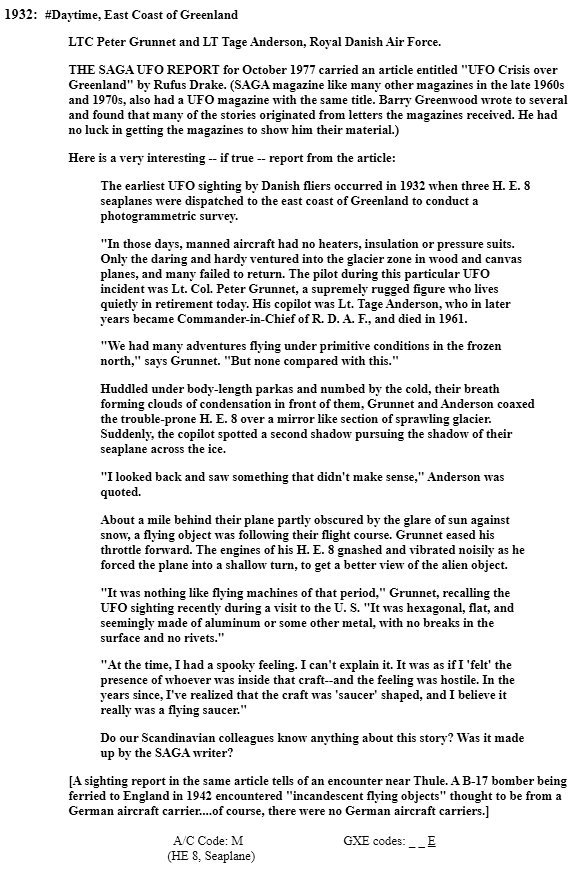
|
1932: # Daytime, East Coast of Greenland
LTC Peter Grunnet and LT Tage Anderson, Royal Danish Air Force.
THE SAGA UFO REPORT for October 1977 carried an article entitled “UFO Crisis over Greenland” by Rufus Drake. (SAGA magazine like many other magazines in the late 1960s and 1970s, also had a UFO magazine with the same title. Barry Greenwood wrote to several and found that many of the stories originated from letters the magazines received. He had no luck in getting the magazines to show him their material.)
Here is a very interesting -- if true -- report from the article:
The earliest UFO sighting by Danish fliers occurred in 1932 when three H. E. 8 seaplanes were dispatched to the east coast of Greenland to conduct a photogrammetric survey.
“In those days, manned aircraft had no heaters, insulation or pressure suits. Only the daring and hardy ventured into the glacier zone in wood and canvas planes, and many failed to return. The pilot during this particular UFO incident was Lt. Col. Peter Grunnet, a supremely rugged figure who lives quietly in retirement today. His copilot was Lt. Tage Anderson, who in later years became Commander-in-Chief of R. D. A. F., and died in 1961.
“We had many adventures flying under primitive conditions in the frozen north,” says Grunnet. "But none compared with this."
Huddled under body-length parkas and numbed by the cold, their breath forming clouds of condensation in front of them, Grunnet and Anderson coaxed the trouble-prone H. E. 8 over a mirror like section of sprawling glacier. Suddenly, the copilot spotted a second shadow pursuing the shadow of their seaplane across the ice.
“I looked back and saw something that didn't make sense,” Anderson was quoted.
About a mile behind their plane partly obscured by the glare of sun against snow, a flying object was following their flight course. Grunnet eased his throttle forward. The engines of his H. E. 8 gnashed and vibrated noisily as he forced the plane into a shallow turn, to get a better view of the alien object.
“It was nothing like flying machines of that period,” Grunnet, recalling the UFO sighting recently during a visit to the U. S. “It was hexagonal, flat, and seemingly made of aluminum or some other metal, with no breaks in the surface and no rivets.”
“At the time, I had a spooky feeling. I can't explain it. It was as if I 'felt' the presence of whoever was inside that craft--and the feeling was hostile. In the years since, I've realized that the craft was 'saucer' shaped, and I believe it really was a flying saucer.”
Do our Scandinavian colleagues know anything about this story? Was it made up by the SAGA writer?
(A sighting report in the same article tells of an encounter near Thule. A B-17 bomber being ferried to England in 1942 encountered "incandescent flying objects" thought to be from a German aircraft carrier... of course, there were no German aircraft carriers.)
A/C Code: M
(HE 8, Seaplane) GXE codes: _ _ E
The “#” sign immediately after the date 1932 at the beginning of this report is explained by Jan Aldrich, the editor, as meaning that the credibility of the case is questionable.
[Ref. gvo1:] GODELIEVE VAN OVERMEIRE:
1932
GREENLANDE [sic], east coast
Observation in broad daylight by pilots LTC Peter Grunnet and LT Tage Anderson, of the Royal Danish Air Force. “One of the first observations by Danish aviators took place in 1932 when 8 H.E. planes were sent to the east coast of Greenland for photogrammetric surveillance. At that time, the planes were not equipped with heating and the aviators did not have no insulating suit yet. So we sent the strongest and boldest. Lt. Col. Peter Grunnet, had as co-pilot Lt. Tage Anderson, who later became commander-in-chief of the RDAF and who died in 1961. Wrapped up in long parkas and numbed by the cold, they saw their breath condense in front of their faces. They were flying at that moment above a glacier, shining like a mirror. Suddenly they saw in this “mirror” a second shadow added to that of their plane. “I looked back and saw something incredible,” said Anderson. A mile behind them they were being followed by an object flying on the same route. So Grunnet began a turn to get a better view of the unknown plane. “It didn't look like anything known at the time,” said Grunnet, “it was hexagonal in shape, completely flat, apparently made of aluminum or some other metal, with no openings, nothing, everything smooth, no bolts or rivet. I had a strange feeling, as if what or who was in this unknown object was hostile to me. I cannot explain this feeling. It was only in the following years that I realized that this object was in the shape of a saucer. “THE SAGA UFO REPORT” for October 1977, article “UFO Crisis over Greenland” by Rufus Drake.
OTHER SOURCES:
There seems to be no other interesting source about the incident so far. I will not go into an uncredited copy of Project 1947's file in the e-book “They Know, You Don't!” by one Silviu Sulita in 2016, claiming that this is some kind of evidence for the “Nazi saucers” theory; or the unsourced RR0 Website (below) summary at https://rr0.org/time/1/9/3/2/

|
The H. E. 8 plane indicated in the reports is actually the German Heinkel He-8 seaplane (photo below), a two/three-seat reconnaissance floatplane powered by a 335kW British Armstrong Siddeley Jaguar radial engine. It was built in Germany in the late 1920s, being developed at the request of the Danish Naval Air Service who received at least 22 He-8 under the designation H.M.II, many remaining operational throughout the 1930s.
The armament comprised a rear-mounted machine-gun, and it was able to carry 12 0.5 kg (1.1 lb) bombs.
The maximum level speed was 218km/h and the range was 1,290 km (800 miles, 700 nautical miles).
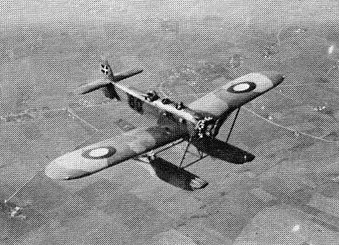
|
Regarding the plane, the first issue I thought I found was that the alleged Danish witnesses should have been more likely to designate their plane as “H.M.II”, or maybe “He 8” or “He-8”, rather than “H. E. 8”. “H. E.” is meaningless, the proper spelling would be the usual German convention, “He” for Heinkel.
But then I found out that many aviation historians also refer to this plane as the “H. E. 8” - example in the screenshot below.
Of course this could have been an honest misspell by the SAGA writer, it would not have been strong proof of hoaxing anyway.
The second issue is that the report claims that the two pilots were officers of the “Royal Danish Air Force”; but those seaplanes were piloted by officers of the Danish Naval Air Service, party of the Royal Danish Navy, not of the Royal Danish Air Force.
History indicates that in the years from 1932-38 the Danish seaplanes H.M.II's “made a systematic Arial photography and mapping surveys in cooperation with the Geodetic Institute of vast areas in Greenland for production of maps.”
(See for example: http://www.navalhistory.dk/English/NavAir/NavalAviation.htm)
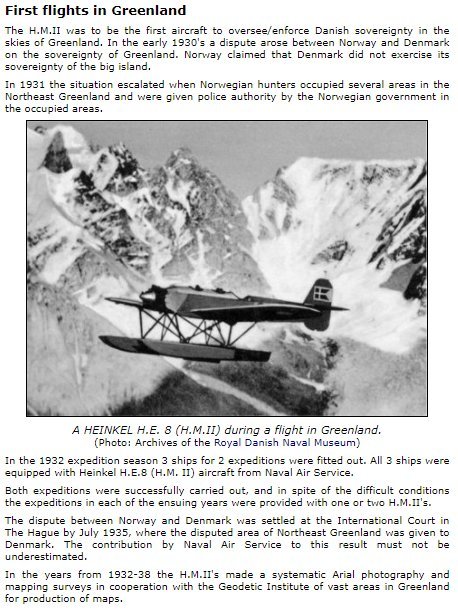
|
Thus, so far as the plane and the circumstances of its use are concerned, the only credibility issue I found with this report is that the planes were Navy planes, not Air Force planes.
The Project 1947 brings an argument as follow: the same SAGA UFO Rreport issue tells of another case in which the UFOs were “thought to be from a German aircraft carrier”; Project 1947 sees a credibility issue with the case discussed here as “of course, there were no German aircraft carriers”.
But there was a German aircraft carrier. The Germans had built the “Graf Zeppelin” aircraft carrier (photo below), the only one they built during WWII. It was decided to build it in 1935, the construction started in 1936 in the Deutsche Werke in Kiel. It was put at sea on December 8, 1938, about 85-90% complete in May 1940; but the construction was never finished and it never participated in the combats. However, because Allied Intelligence would not have excluded that it would start operating at any time, the witnesses of the related case might have in honest error thought that what they saw came from it, so the “German aircraft carrier” affair does not bear much on the credibility of the 1932 Greenland case.
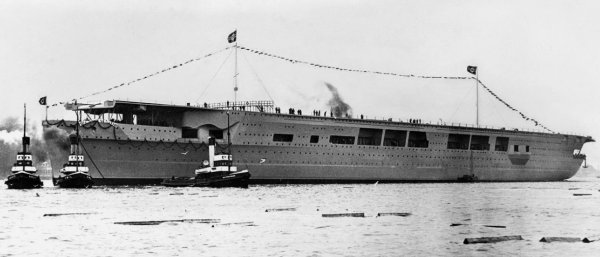
|
Drake was a U.S. journalist at SAGA UFO Report who was interested in UFOs and “mysteries” such as the Bermuda Triangle saga; he interviewed UFO witnesses, and published UFO witnesses' letters in SAGA.
I miss the SAGA article so far, but I can confirm that Rufus Drake did sign an article in SAGA UFO Report for October 1977.
We are told that in later years he became Commander-in-Chief of R. D. A. F. and died in 1961.
I was able to partly confirm this: Tage Andersen, (of course, not “Anderson”), was Chief in the Army Aviation Troops (not the Air Forces, not the Navy Air Service) with the rank of Colonel for about two years, 1945 - 1947. He was born in 1899 and died in 1965, not 1961.
He was Lieutenant General from November 1, 1955, to June 15, 1959 (226 days), of the Air Command.
(See for example https://military.wikia.org/wiki/Chief_of_the_Royal_Danish_Air_Force#Army_Aviation_Troops_.281917.E2.80.931947.29 )
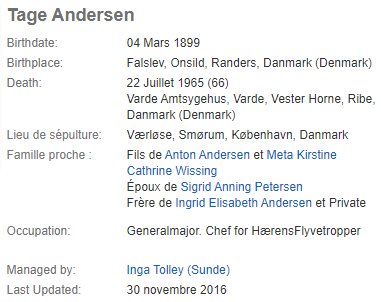
|
As for his late career, I found out in the New York Times for July 24, 1965, that at age 66, he was a General and a NATO Air Commander.
Thus, we have a misspell on the name, an error on the death date, and an overrated role as “Commander-in-Chief of R. D. A. F.”, but we also have every reason to think that this pilot did exist and could have been one of the two witnesses for this sighting.
I found no information about him; of course that are many “Peter Grunnet” in Denmark, and the name might have been misspelled too.
“Roswell incident” students would remember that somewhat hexagonal-shaped tinfoil-and-sticks radar targets may be mistaken for UFOs; but in this case it makes no sense since there were no radar at all in 1932. I do not see any natural or artificial object likely to be in the air in 1932 that would appear hexagonal.
The sighting must have taken place in daylight because the seaplanes were there to “conduct a photogrammetric survey”; hardly something to do in the night. So it would not have been some hexagonal-shaped aurora borealis as those are not visible to human eyes in daytime. Of course they do not cast a shadow on the ground either.
My impression here is that this case may really be a “good” case. At least it would deserve some attempts at answer or comment to Jan Aldrich's apparently unanswered question “Do our Scandinavian colleagues know anything about this story?”
Possible extraterrestrial craft.
* = Source is available to me.
? = Source I am told about but could not get so far. Help needed.
| Main author: | Patrick Gross |
|---|---|
| Contributors: | None |
| Reviewers: | None |
| Editor: | Patrick Gross |
| Version: | Create/changed by: | Date: | Description: |
|---|---|---|---|
| 0.1 | Patrick Gross | September 24, 2023 | Creation, [prt1]. |
| 1.0 | Patrick Gross | September 24, 2023 | First published. |
| 1.1 | Patrick Gross | November 9, 2023 | Additions [jah1], [gvo1]. |